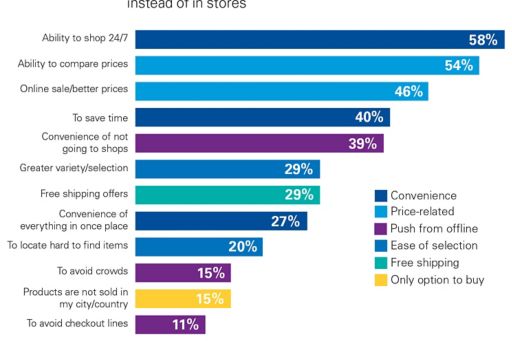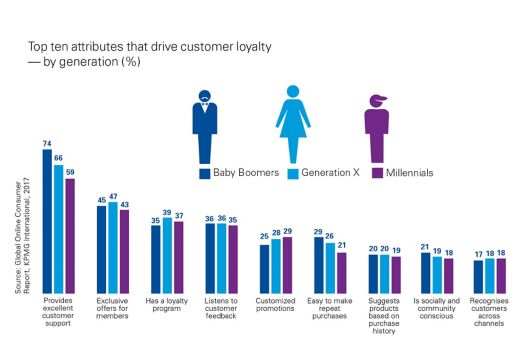Consumer attitudes and motivations
Consumer attitudes and motivations
Understanding what drives a customer to buy online or offline is critical for companies when formulating their brand, market positioning, and overall experience offering.

What drives a customer to buy online or offline in the first place? Why do they trust some companies or websites over others? And what motivates someone to become a repeat customer or loyal ambassador? Understanding these consumer sentiments is critical for companies when formulating their brand, market positioning and overall experience offering.
Choosing online
When consumers were asked what factors motivated them to buy online instead of going to a shop, the top reasons were time flexibility and cost savings.

Consumers also said they preferred shopping online to avoid the negative experiences associated with going out to shops—these consumers in a way are ‘pushed’ online by the inconveniences of traveling to a shop, being in a crowd, or standing in checkout lines. This was particularly evident in some countries with densely populated cities. Consumers in China, India and Singapore, for example, were the most likely to say crowd avoidance was a top motivator to shop online.
Another key driver for some who are buying online is access to products not otherwise available in local shops. Although on average this was one of the least common reasons for shopping online, in certain regions such as Latin America and Asia-Pacific, it was cited as a top reason by a quarter to nearly half of all consumers.
The countries where consumers were most likely to shop online out of necessity tend to be those where product availability or selection is limited, or where much of the population lives in remote areas with limited access to shops or certain goods.
Choosing offline
Although the percentage of total retail sales made online is unquestionably growing, on average, the majority of consumer purchases are still made in shops.
Only 23 percent of consumers said they prefer visiting shops to enjoy the shopping experience. Most often, it is because they want to see touch, try on, or verify the appearance or features of a product before buying. Retailers looking to drive online sales of products that consumers are less willing to buy sight unseen may use strategies to persuade them to shop online. These might include providing comprehensive sizing and measuring charts, detailed photographs with 360° and zoom viewing, free fabric swatches by mail, satisfaction guarantees, or easy returns, to name a few.

As consumers continue to shift their shopping to online, retailers who understand the factors motivating them to shop online or in-store will be better positioned to create sales channels that meet their customers’ evolving needs and preferences.
Winning the online consumer
As explained in the previous chapter, during the conversion stage, having the most competitive price won’t guarantee a sale. Although price was cited by 57 percent of consumers as a top factor in deciding which website to buy from, the next key attributes were enhanced delivery options and easy return policies.

In China, delivery options ranked even higher than price, and in India and Turkey, easy return policies was the most commonly cited attribute.
Millennials have a much higher demand for instant gratification than older generations. Although younger consumers are increasingly comfortable with buying products online without seeing them first, they are almost twice as likely to say they’d rather visit shops to get their product right away, rather than buy online and await delivery.
Companies will need to continually innovate to shorten delivery times and satisfy increasingly demanding consumer expectations.
Customer loyalty
While consumer trust can be the key to a company’s success, the coveted prize is to win customer loyalty. Ideally, these customers not only develop an allegiance to a company, but they also become brand ambassadors, encouraging others to follow suit.
What makes consumers loyal to one company over another? Is a good experience and company trust enough to ensure they will return? When consumers were asked about the attributes of the companies they were most likely to be loyal to, by far the leading response (by 65 percent of respondents) was ‘provides excellent customer support’.
Finding ways to provide exceptional customer support online can lead to customer loyalty in an online environment, where it can be difficult to stand out or be remembered.
Younger consumers, on the other hand, are more likely looking to be treated as individuals. They tend to be relatively less impressed than the older consumers by excellent customer support, and slightly more impressed than their older counterparts with company offers that have a personal element, such as customized promotions, recognition across channels or an ability to anticipate needs.

As Millennials become a larger proportion of the total consumer market, excellent customer support and loyalty benefits will become minimum expectations. Loyalty will be granted to those companies that make their customers feel like they are part of a community, and one where they feel important, unique and valued.
The bottom line is that to win and retain online customers, companies need to find cost-effective ways of providing the service and quality that customers expect, while keeping prices competitive. Consumers, depending largely on their country, culture or age, as well as on the type of product being purchased, will each be more or less willing to trade-off service or quality for price.
The companies that are able to identify and segment their target customers based on these factors, and develop product offerings and online strategies that are distinctly tailored for each unique market, will be truly poised to succeed in the online revolution.